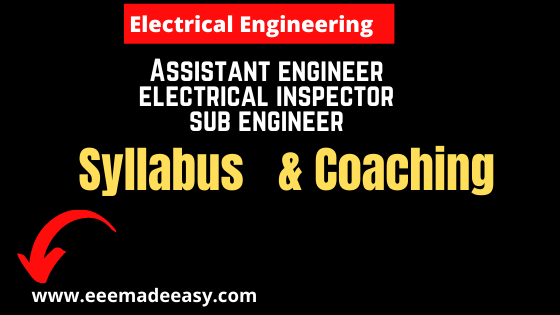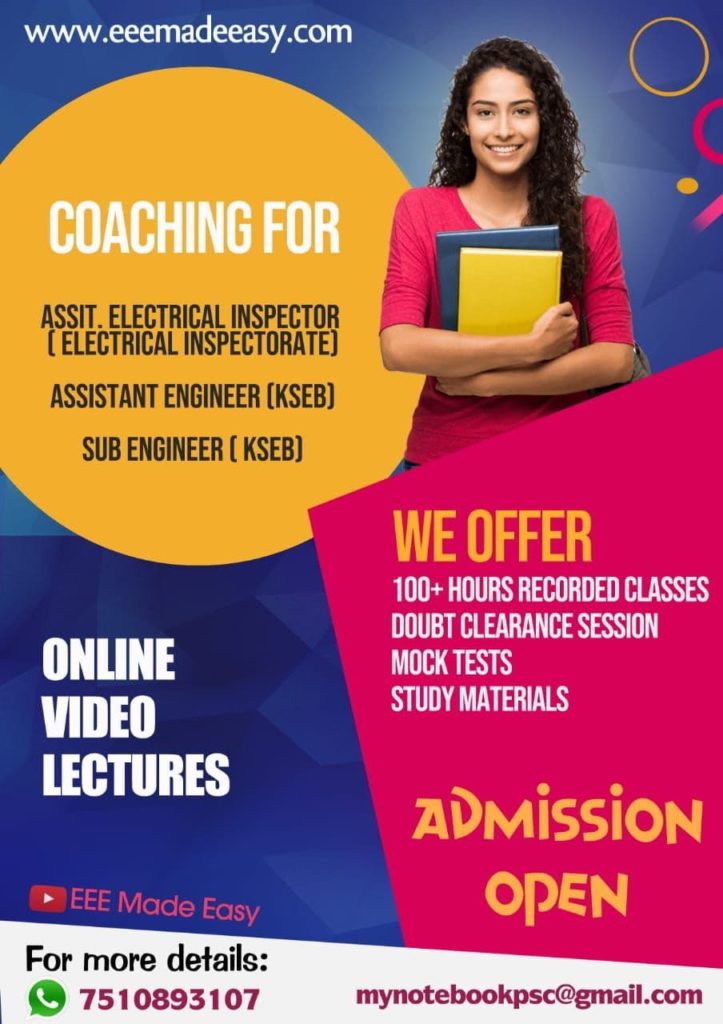
Syllabus of Assistant Electrical Inspector Assistant Engineer Electrical KSEB
ASSISTANT ENGINEER (ELECTRICAL) KERALA STATE ELECTRICITY BOARD Detailed Syllabus
To Join Online Coaching Fill this Form HERE or whatsapp on 7510893107
Module I:
Electric circuits :
Network graph. KCL,KVL, node and mesh analysis, transient response of dc and ac networks; sinusoidal steady state analysis, resonance, basic filter concept; ideal current and voltage sources, Thevenin’s, Norton’s, superposition and Maximum power transfer theorems, two port network,
three phase circuits:
Electromagnetics:
Gauss Theorem, electric field and potential due to point, line, plane and spherical charge distribution; Ampere’s and Biot-Savart ‘s law; inductance; dielectrics;capacitance.
Signals and systems:
Representation of continuous and discrete-time signals; shifting and
scaling operation; liner time-invariant and causal systems: Fourier, Laplace and Z transforms.
Instrumentation:
Insulation megger, earth megger, Kelvin’s Double bridge, Quadrent
electrometer, Rotating sub-standard, TOD meter.
Module II:
Electrical Machines:
Single phase transformer – equiva l ent circuit, phasor diagram,
tests, regulation and efficiency; three phase transformers – connections, parallel operation; auto-transformer; energy conversion principles;
DC machines – types, windings, generator characteristics, armature reaction and commutation, starting and speed control of motors; three phase induct ion motors – principles, types, performance characteristics, starting and speed control: single phase induction motors; synchronous machines – performance, regulation and parallel operation of generators, motor starting, characteristics and applications; servo and stepper motors.
Electrical Machine Design:
Design of transformers – single phase and three phase
transformers – distribution and power transformers – output equation – core design – window area – window space factor – overall dimensions of core. Windings – no. of turns – current density) – conductor section –
Design of DC machines:
output equation – specific loading – choice of speed and no of poles – calculation of main dimensions – choice of type of winding –
number of slots – number of conductors per slot – length of air gap – design of field windin g – conductor cross section – design of interpole – flux density under interpole – calculation of turns of interpole wi n d i n g – design of compensating winding.
Design of synchronous machines:
specific loading – output equation – main dimensions – types
of winding – number of turns – number of slots and slot design – field design for water wheel and turbo-alternators – cooling of alternators.
Design of three-phase induction motors: main dimensions – stator design – squirrel cage and slip ring types – number of stator and rotor slots – rotor bar current – design of rotor bar – end ring current -design of end ring – design of s l ip ring rotor winding.
To Join Online Coaching Fill this Form HERE
Module III:
Power Systems:
Basic power generation concepts; transmission l ine models and performance; cable performance, insulation; corona and radio interference; distribution systems; per-unit quantities; bus impedance and admittance matrices; load flow; voltage control; power factor correction; economic operation; symmetrical components; fault analysis; principles of over-current, differential and distance protection; solid state relays and
digital protection; ci rcui t breakers; system stability concepts, swing curves and equal area criterion; HDVC transmission.
Control Systems:
Principles of feedback; transfer function; block diagrams; steady-state
errors; Routh and Niquist techniques; Bode plots; root loci; lag, lead and lead-lag compensation; state space model; state transition matrix, controllability and observability
Electrical and Electronic Measurements:
Bridges and potentiometers; PMMC, moving iron,
dynamometer and induct ion t yp e instruments; measurement of vol tage, current, power, energy and power factor; instrument transformers; digital voltmeters and multimeters; phase, time and frequency measurement; Q-meters; oscilloscopes; potentiometric recorders; error analysis.
Module IV: (A)
Analog and Digital Electronics:
Characteristics of diodes. BJT, MOSFET, amplifiers –
biasing, equivalent circuit and frequency response; oscillators and feedback amplifiers; operational amplifiers – characteristics and applications; simple active filters: VCOs and timers; combinational and sequential logic circuits; multiplexer; Schmitt trigger; multivibrators; sample and hold circuits; A/D and D/A converters; 8-bit microprocessor basics, architecture, programming and interfacing.
Power Electronics and Drives:
Semiconductor power diodes, transistors, thyristors, triacs,
GTOs, MOSFETs and IGBTs – static characteristics and principles of operation; triggering circuits; phase control rectifiers; bridge converters – fully controlled and ha l f controlled; principles of choppers and inverters; basis concepts of adjustable speed dc and ac drives.
Module IV: (B)
Electrical system Design:
Medium and HV installations – selection of cables and cable
glands, guidelines for cable installation, Installation of induction motors, Design of distribution systems with light power and motor loads, Selection and instal lation of transformers, switchgears and protective devices – Design of indoor and outdoor 11 KV substation upto 630 KVA –
Design of earthing system – Pipe, plate and mat earthing – lightning arresters.
Metering and protection. HT and LT breaker control panels. Selection of standby generator – installation and its protection. Pre-commissioning tests of cables, transformers and generators.
Sub Engineer Electrical Syllabus Download PDF HERE
Online Courses By EEE Made Easy
To Join Online Coaching Fill this Form HERE
Online Coaching Specialties
Recorded Classes (Classes can be attended at your convenient time)
Doubt Clearance sessions( at 9 pm)
Online Mock tests ( After the completion of Each chapter)
Previous Question paper Practice
Fill the Course contact form HERE
Download Syallabus pdf HERE
| Basic Electrical Engineering MCQ’s From Notebook Site (www.notebukofaprofessor.blogspot.com) |
| 1. Basic Electrical Engineering MCQ 1 |
| 2. Current Electricity MCQ |
| 3. Basic Electrical MCQ 2 |
| 4. Basic Electrical Engineering MCQ 3 |
| 5. Basic Electrical Engineering MCQ 4 |
| 6. Basic Electrical Engineering MCQ 5 |
| 7. Basic Electrical Engineering MCQ 6 |
| 8. Basic Electrical Engineering MCQ 7 |
| 9. Basic Electrical Engineering MCQ 8 |
| 10. Basic Electrical Engineering MCQ 9 |
| 11. Basic Electrical Engineering MCQ 10 |
| 12. Basic Electrical Engineering MCQ 11 |
| 13. Basic Electrical Engineering MCQ 2 |
| 14. Basic Electrical Engineering MCQ 14 |
